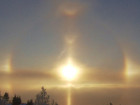|
Show off your work
|
|
| midtskogen | Date: Sunday, 13.11.2016, 23:47 | Message # 1081 |
 Star Engineer
Group: Users
 Norway
Norway
Messages: 1674
Status: Offline
| Yes, the striking feature of this plot is the lack of an S wave arrival. It would be interesting to convert this data to audio. Usually one hears two crashes followed by a rumble: P wave arrival, S wave arrival and surface waves. But this should be different. I'm in Korea right now, and accessing my usual tools for doing these kind of things is a bit trickier.
NIL DIFFICILE VOLENTI

Edited by midtskogen - Monday, 14.11.2016, 00:21 |
| |
| |
| midtskogen | Date: Monday, 14.11.2016, 00:05 | Message # 1082 |
 Star Engineer
Group: Users
 Norway
Norway
Messages: 1674
Status: Offline
| An attempt to convert to audio. One hour compressed to 5 seconds. The sound appears very soft to me, and no doubt the distance causes that. But I can barely hear the sound, which may be because my $200 laptop has lousy speakers.
Edit: My phone's speaker is better. There are two crashing sounds right in the beginning. The second could be an echo of some kind, since there will be no S wave (and the delay between them is two small for an S wave anyway). It's not one of the aftershocks either, as the first one large enough for clear detection occurred half an hour later. I can't really hear the surface waves, but the frequencies might be too low for my speakers, even when one hour is compressed to 5 seconds. My seismometer peak sensitivity is around 0.06 Hz, which gets turned to audio around 43 Hz and that is way too low for most speakers.
NIL DIFFICILE VOLENTI

Edited by midtskogen - Monday, 14.11.2016, 00:21 |
| |
| |
| Watsisname | Date: Monday, 14.11.2016, 04:48 | Message # 1083 |
 Galaxy Architect
Group: Global Moderators
 United States
United States
Messages: 2613
Status: Offline
| That second crash seems to be the spike I was mentioning at about 11:28, which based on the graphic is probably the part of the P wave which moved through the mantle and reflected once off the surface before reaching you. At first I thought it surprising that it arrives so soon after the direct wave despite following a longer path, but after going through the math it does make sense.
If we consider a point antipodal to the quake, then the straight line through the Earth is about 12740km. 100km through the crust (both sides), 3900km through mantle, 6200 through the outer core, and 2540 through the inner core. The P-wave velocity changes through all of these, averaging about 7km/s through crust, 10.5km/s through mantle, 9km/s through outer core, and 11km/s through inner core. Then the time it takes to pass through the whole Earth is about 22 minutes.
For the singly-reflected P wave through the mantle, we can imagine (not quite accurately but close enough) that it goes on a straight line to a point 90° away and reflects from there to the antipodal point. This path length is sqrt(2) times the radius of the Earth, times 2, or about 18000km. Then assuming 10.5km/s average speed, it takes about 28 minutes to make that trip. This roughly agrees with the observed waves.
The first surface waves should have arrived somewhere around 40 minutes after the quake. There does seem to be an increase in intensity there, but a lot of other complicated reflections are also reaching you by that point as well.

|
| |
| |
| midtskogen | Date: Wednesday, 30.11.2016, 12:43 | Message # 1084 |
 Star Engineer
Group: Users
 Norway
Norway
Messages: 1674
Status: Offline
| This meteor was detected by my software last night. It made it deep into the atmosphere, down to 34 km, despite it was not very bright at all. I post it here because it was such a nice detection - the software working perfectly as intended, locating stars for fine-tuned calibration and determining the full track from multiple stations. I used to do all this by hand a few years ago, so it's so nice to see it automated. 
NIL DIFFICILE VOLENTI

|
| |
| |
| Hornblower | Date: Wednesday, 30.11.2016, 12:52 | Message # 1085 |
 World Builder
Group: Users
 United States
United States
Messages: 714
Status: Offline
| midtskogen, It would be a cool challenge to try to calculate where it landed so you can go find it and keep it 
|
| |
| |
| midtskogen | Date: Wednesday, 30.11.2016, 13:02 | Message # 1086 |
 Star Engineer
Group: Users
 Norway
Norway
Messages: 1674
Status: Offline
| If anything of this survived, it's currently resting at the bottom of the sea, which saves me from further work on this one.
NIL DIFFICILE VOLENTI

|
| |
| |
| midtskogen | Date: Friday, 02.12.2016, 22:01 | Message # 1087 |
 Star Engineer
Group: Users
 Norway
Norway
Messages: 1674
Status: Offline
| Featured in The Great Courses by Alex Filippenko. The "incredibly bright Iridium flare" was something I shot in the mid 90's.
NIL DIFFICILE VOLENTI

Edited by midtskogen - Saturday, 03.12.2016, 05:36 |
| |
| |
| Mosfet | Date: Saturday, 03.12.2016, 00:42 | Message # 1088 |
 World Builder
Group: Users
 Italy
Italy
Messages: 754
Status: Offline
| You're in the end credits! 
"Time is illusion. Lunchtime doubly so."
Douglas N. Adams
My mods
Asus x555ub: cpu i5-6200u - ram 4gb - gpu nvidia geforce 940m 2gb vram
|
| |
| |
| Watsisname | Date: Saturday, 03.12.2016, 01:23 | Message # 1089 |
 Galaxy Architect
Group: Global Moderators
 United States
United States
Messages: 2613
Status: Offline
| Neat! It's a spectacular shot. 

|
| |
| |